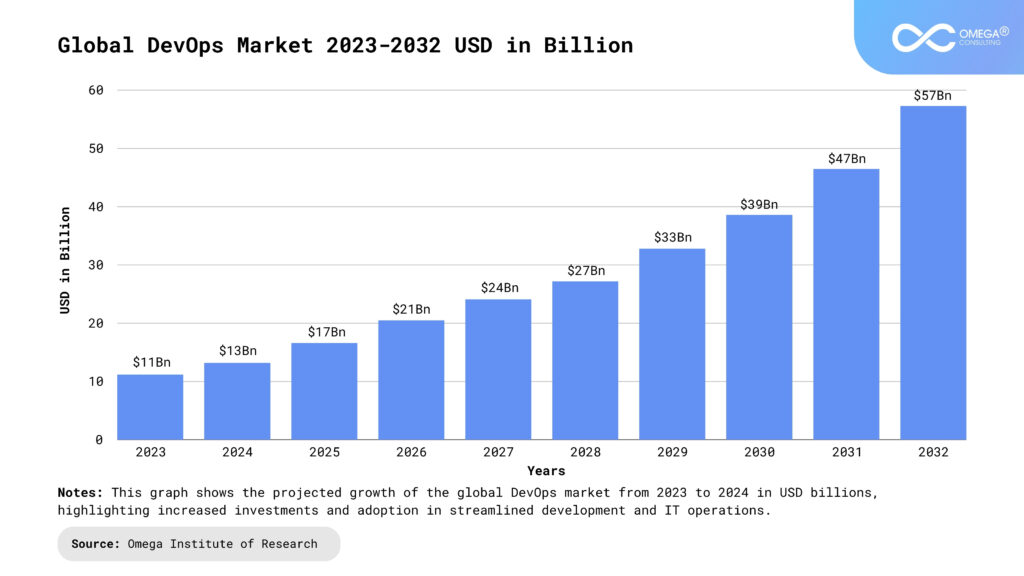- Industries
Industries
- Functions
Functions
- Insights
Insights
- Careers
Careers
- About Us
- Technology
- By Omega Team

The use of DevOps methods has transformed software development teams’ ability to produce high-caliber products in the quickly changing field of software development. Version control is one of the key elements that makes DevOps successful. VCSs, or version control systems, are now essential for handling the complexity of contemporary software development. The significance, tools, best practices, and upcoming trends of version control in DevOps are examined in this in-depth study.
The Importance of Version Control in DevOps
Version control systems are essential in DevOps for several reasons:
Collaboration
In a DevOps environment, multiple developers often work on the same codebase simultaneously. Version control systems facilitate seamless collaboration by allowing developers to work on different branches, merge changes, and resolve conflicts. This ensures that the code remains consistent and stable.
Code History and Auditing
Version control systems maintain a detailed history of changes made to the codebase. This historical record is crucial for auditing, debugging, and understanding the evolution of the software. It allows teams to track changes, identify who made specific changes, and revert to previous versions if necessary.
Continuous Integration and Continuous Deployment (CI/CD)
CI/CD pipelines are a cornerstone of DevOps practices. Version control systems integrate with CI/CD tools to automate the process of building, testing, and deploying code. This integration ensures that code changes are continuously tested and deployed, reducing the risk of introducing errors into the production environment.
Disaster Recovery
Version control systems provide a safety net for disaster recovery. In the event of a critical failure or data loss, teams can quickly restore the codebase to a previous stable state. This minimizes downtime and ensures business continuity.

Popular Version Control Systems
Several version control systems are widely used in the DevOps ecosystem. Each has its strengths and is suited for different use cases.
Git
Git is the most popular distributed version control system. It allows developers to work on local repositories, providing flexibility and speed. Key features of Git include:
- Branching and Merging: Git’s branching model is highly efficient, enabling developers to experiment with new features and merge changes seamlessly.
- Distributed Nature: Developers can work offline and sync their changes when connected to the network, making Git suitable for remote and distributed teams.
- Integration with CI/CD Tools: Git integrates seamlessly with various CI/CD tools, facilitating automated testing and deployment.
Subversion (SVN)
Subversion, commonly known as SVN, is a centralized version control system. It has been widely used in enterprise environments. Key features of SVN include:
- Centralized Repository: All changes are committed to a central repository, ensuring a single source of truth.
- File Locking: SVN supports file locking, preventing conflicts when multiple developers work on the same file.
- Access Control: SVN provides robust access control mechanisms, making it suitable for organizations with strict security requirements.
Mercurial
Mercurial is another distributed version control system known for its simplicity and performance. Key features of Mercurial include:
- Ease of Use: Mercurial is designed to be user-friendly, with a straightforward command-line interface.
- Scalability: Mercurial handles large repositories efficiently, making it suitable for projects of all sizes.
- Extensibility: Mercurial supports extensions, allowing teams to customize the system to meet their specific needs.
Perforce
Perforce, also known as Helix Core, is a version control system favored by large enterprises and game development studios. Key features of Perforce include:
- High Performance: Perforce is optimized for handling large binary files and extensive codebases.
- Strong Security: Perforce offers robust security features, including access controls and auditing capabilities.
- Scalability: Perforce is designed to scale to meet the needs of large, complex projects with numerous contributors.

The Role of Version Control in DevOps
Collaboration and Integration: Version control is fundamental to the collaborative nature of DevOps. It allows developers to work on different parts of a project simultaneously without interfering with each other’s progress. Changes are merged seamlessly, reducing conflicts and enhancing productivity.
Automation and Continuous Integration: Continuous Integration (CI) is a core DevOps practice that involves automatically integrating code changes into a shared repository several times a day. Version control systems trigger CI pipelines, running automated tests and builds, ensuring that the code is always in a deployable state.
Traceability and Accountability: Version control systems maintain a comprehensive history of all changes made to the codebase. This traceability is crucial for accountability, auditing, and compliance purposes. It also aids in debugging by allowing developers to pinpoint when and where a bug was introduced.
Disaster Recovery and Backup: With version control, every change is recorded and stored. This feature acts as a backup mechanism, enabling teams to recover previous versions of the code if something goes wrong. It also provides a safety net during deployments, allowing quick rollbacks in case of failures.
Branching and Merging: Modern VCS like Git support branching, a feature that allows developers to create isolated environments for developing new features or fixing bugs. These branches can be merged back into the main codebase after thorough testing, facilitating parallel development and enhancing code quality.
Benefits of Version Control in DevOps
Improved Collaboration: Teams can work together more efficiently, sharing code and reviewing each other’s changes. This collaborative environment fosters innovation and accelerates development cycles.
Enhanced Quality and Stability: Continuous integration and automated testing ensure that new code is regularly tested and integrated, reducing the chances of introducing bugs into the production environment.
Increased Flexibility: Version control systems support branching and merging, enabling teams to experiment with new ideas without affecting the main codebase. This flexibility encourages creative problem-solving and innovation.
Better Release Management: With version control, managing releases becomes more straightforward. Teams can track versions, manage dependencies, and ensure that releases are stable and well-documented.
The 7Cs of DevOps
The 7Cs of DevOps represent a comprehensive approach to software development and deployment, with a strong emphasis on collaboration and continuous improvement:
Continuous Operation
This ensures the software continues to function smoothly and reliably post-deployment. Continuous monitoring, maintenance, and support are essential to provide uninterrupted services for end users.Continuous Planning
DevOps promotes continuous planning to align business objectives with development goals. It employs iterative planning cycles, allowing for adaptation to changing market conditions and technological advancements.Continuous Integration
This involves regularly incorporating code changes into a shared repository. It ensures that developers’ code integrates seamlessly, reducing integration issues and enabling rapid feedback loops.Continuous Testing
DevOps encourages continuous testing at every development stage. Automated testing ensures high software quality and reliability by enabling the rapid detection and resolution of issues.Continuous Monitoring
This involves real-time monitoring of applications and infrastructure. It provides insights into system performance, identifies bottlenecks, and allows for proactive adjustments to ensure optimal performance and availability.Continuous Delivery
Automating the deployment pipeline is crucial in DevOps, enabling more frequent and reliable software releases. It ensures code updates are always deployment-ready, allowing for quicker delivery to end users.Continuous Feedback
This aspect establishes a feedback loop among teams and stakeholders. Feedback helps identify areas for improvement, refine processes, and enhance collaboration, driving continuous improvement throughout the development lifecycle.
Best Practices for Version Control in DevOps
Implementing version control effectively requires adherence to best practices. These practices ensure that the version control system enhances productivity and maintains the integrity of the codebase.
Use a Branching Strategy
A well-defined branching strategy is crucial for managing code changes efficiently. Common branching strategies include:
- Feature Branching: Developers create separate branches for each feature or task. This isolates changes and makes it easier to manage different workstreams.
- Git Flow: Git Flow is a popular branching model that defines specific branches for development, testing, and production. It provides a structured approach to managing releases and hotfixes.
- Trunk-Based Development: In this approach, developers commit small, incremental changes directly to the main branch. This strategy emphasizes continuous integration and reduces the overhead of managing multiple branches.
Commit Early and Often
Frequent commits ensure that changes are incremental and easier to review. Each commit should represent a logical unit of work, making it simpler to identify the source of bugs and revert changes if necessary.
Write Descriptive Commit Messages
Clear and descriptive commit messages are essential for maintaining a readable and understandable code history. Commit messages should explain the purpose of the change and provide context for future reference.
Code Reviews and Pull Requests
Code reviews are a critical part of the DevOps workflow. They ensure that changes are reviewed by peers before being merged into the main codebase. Pull requests facilitate this process by providing a platform for discussion and feedback.
Automate Testing and Deployment
Integrating version control with automated testing and deployment pipelines is fundamental to DevOps. Automated tests should run on every commit, providing immediate feedback on the quality of the code. Deployment pipelines should automate the process of deploying code to different environments.
Maintain a Clean Repository
Regularly clean up and archive obsolete branches to keep the repository manageable. A clean repository reduces clutter and makes it easier for developers to find relevant branches and commit histories.
Case Studies: Version Control in Action
Google
Google uses a custom version control system called Piper, which supports its massive codebase. Piper is designed to handle the scale of Google’s development efforts, allowing thousands of engineers to work on millions of lines of code. The system emphasizes performance, scalability, and integration with Google’s CI/CD pipeline.
Facebook
Facebook leverages Mercurial for its version control needs. Mercurial’s performance and scalability make it suitable for Facebook’s extensive codebase and large development team. Facebook has also contributed to the development of Mercurial, enhancing its capabilities to meet the company’s specific requirements.
Netflix
Netflix uses Git for version control, integrated with a sophisticated CI/CD pipeline. Netflix’s deployment model relies heavily on automation, with continuous testing and deployment ensuring that new features and updates are delivered rapidly and reliably.
Future Trends in Version Control
The landscape of version control is continuously evolving, driven by advancements in technology and changing development practices. Several trends are shaping the future of version control in DevOps:
AI and Machine Learning Integration
AI and machine learning are poised to transform version control systems. These technologies can enhance code review processes by automatically identifying potential issues, suggesting improvements, and predicting the impact of changes. AI-driven analytics can also provide insights into development patterns and team productivity.
Enhanced Security Features
As cybersecurity threats become more sophisticated, version control systems are incorporating advanced security features. These include enhanced access controls, encryption, and anomaly detection to protect the integrity of the codebase.
Improved Collaboration Tools
Collaboration is at the heart of DevOps, and version control systems are evolving to support more seamless and intuitive collaboration. This includes real-time code editing, integrated communication tools, and advanced conflict resolution mechanisms.
Cloud-Native Version Control
The shift to cloud-native development is influencing version control systems. Cloud-native version control solutions offer scalability, flexibility, and integration with cloud-based CI/CD pipelines. These systems enable teams to manage code more efficiently in distributed and dynamic environments.
Decentralized Version Control
Decentralized version control systems are gaining traction, offering greater autonomy and resilience. These systems allow developers to work independently, with changes synchronized across the network. This approach is particularly beneficial for remote and distributed teams.
Conclusion
Version control is the backbone of DevOps, enabling modern software development practices that emphasize collaboration, automation, and continuous delivery. By adopting robust version control systems and adhering to best practices, development teams can enhance productivity, improve code quality, and accelerate time-to-market. In an era where software is the driving force behind business innovation, mastering version control in the context of DevOps is not just beneficial—it’s essential.By integrating version control effectively within a DevOps framework, organizations can navigate the complexities of modern software development with agility and confidence. As technology continues to evolve, so too will the tools and practices that define the future of DevOps and version control.
- https://medium.com/@webelightsolutions/exploring-version-control-in-devops-use-case-benefits-top-tools-416e9ce5274e
- https://successive.tech/blog/devops-in-modern-software-development/
- https://www.intelivita.com/blog/role-of-devops-in-software-development/
- https://www.shiksha.com/online-courses/articles/unlocking-devops-success-with-version-control/
Subscribe
Select topics and stay current with our latest insights
- Functions